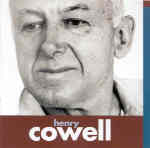Henry Cowell remains arguably the most shamefully neglected major American composer. All the usual charges are leveled against him: he was stylistically eclectic, his music vacillates between avant-garde and hopelessly naïve, he wrote too much–generic arguments made mostly by people comfortably ignorant of the actual music. In fact, Cowell was a sort of horizontal Charles Ives. Where Ives took every musical “found” object he could get his hands on and piled them all up at once, damn the consequences, Cowell tended to spread his discoveries out one work at a time. And so Hymn and Fuguing Tune No. 3 (one of the larger settings including much brass and percussion) sounds as American as Ongaku does Japanese, and neither could be pinned on the door of a guy named “Cowell” to the extent that they reveal a distinct personal style. Yet both are indisputably terrific music.
The same applies to the two symphonies. Indisputably personal they are not, but good heavens, how interesting they are purely as music! No. 11 begins with a haunting lullaby and follows the stages of a man’s life through seven “rituals”, alternating between relatively conventional scoring for strings and winds and some really freaky writing for full orchestra with extensive percussion. It’s tuneful, fresh, and not a minute too long. Symphony No. 15 has a similarly fascinating structure: five tiny movements, a “recapitulation” that combines elements from all of them, and a sonata-form finale. As in No. 11, Cowell finds attractive music to color in the work’s formal outlines, and at about 20 minutes each there’s no reason why these works don’t appear regularly on concert programs.
The Louisville Orchestra delivers secure and characterful performances of all four pieces, with very little of the strident trumpet or thin string sound that sometimes mars its efforts in larger, more virtuosic repertoire. Aside from the Hymn and Fuguing Tune No. 3, all of these recordings are mono, but the high level transfers offer wide-ranging sonics and very clear, natural balances. The importance of this release to 20th century American music can’t be exaggerated, nor can the enjoyment that sympathetic listeners will derive from it. [3/13/2003]
































